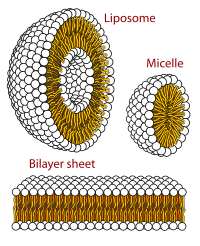
Photo from wikipedia
Changes in luminescence due to solution-mediated phase transition (SMPT) and crystal-to-crystal phase transitions of a novel cyclometalated platinum(II) complex with isoquinoline-1-carboxylate (Iq-1-COO-) [Pt(bzq)(Iq-1-COO)] (bzq-: benzoquinolinate) were studied experimentally and theoretically.… Click to show full abstract
Changes in luminescence due to solution-mediated phase transition (SMPT) and crystal-to-crystal phase transitions of a novel cyclometalated platinum(II) complex with isoquinoline-1-carboxylate (Iq-1-COO-) [Pt(bzq)(Iq-1-COO)] (bzq-: benzoquinolinate) were studied experimentally and theoretically. Recrystallization of the complex allowed three crystal forms depending on the solvent: red polymorph RDMF (λemi = 689 nm), yellow polymorph YDMSO (λemi = 641 nm), and red pseudopolymorph RBCHCl3 (λemi = 721 nm). Crystals of RDMF in the DMF solution at room temperature showed SMPT to yellow crystals YDMF (λemi = 627 nm), in which RDMF first dissolved partly into the solution, and then the dissolved complex crystallized as YDMF. RBCHCl3 exhibited crystal-to-crystal phase transitions to RDMF and YDMF by being heated to 150 °C and stored in atmospheric conditions, respectively. Molecular structures of each of the four crystal forms, analyzed by X-ray crystallography, showed different planarities because of the dihedral angles between the bzq- and Iq planes being 3.15, 4.80, 8.35, and 17.7° for RBCHCl3, RDMF, YDMSO, and YDMF, respectively. The planar complexes in RDMF and RBCHCl3 constructed dimers through intermolecular Pt-Pt and π-π interactions, whereas the distorted complexes in YDMF and YDMSO remained as monomers. Density functional theory (DFT) calculations, which reveal the relation between the molecular structure and thermodynamic stability, suggest that the SMPT is triggered by thermodynamic transformation from the metastable planar structure to the stable distorted structure. The intradimer interactions in RDMF and RBCHCl3 induced red-shifts in the absorption and emission colors from those of YDMF and YDMSO; thus, the photophysical properties of RBCHCl3 and RDMF originate from the MMLIqCT state in contrast with the MLIqCT/LbzqLIqCT character for YDMF and YDMSO. DFT and time-dependent DFT (TD-DFT) calculations in the ground and excited states provide insight into the structural, electronic, and optical properties.
Journal Title: Inorganic chemistry
Year Published: 2017
Link to full text (if available)
Share on Social Media: Sign Up to like & get
recommendations!